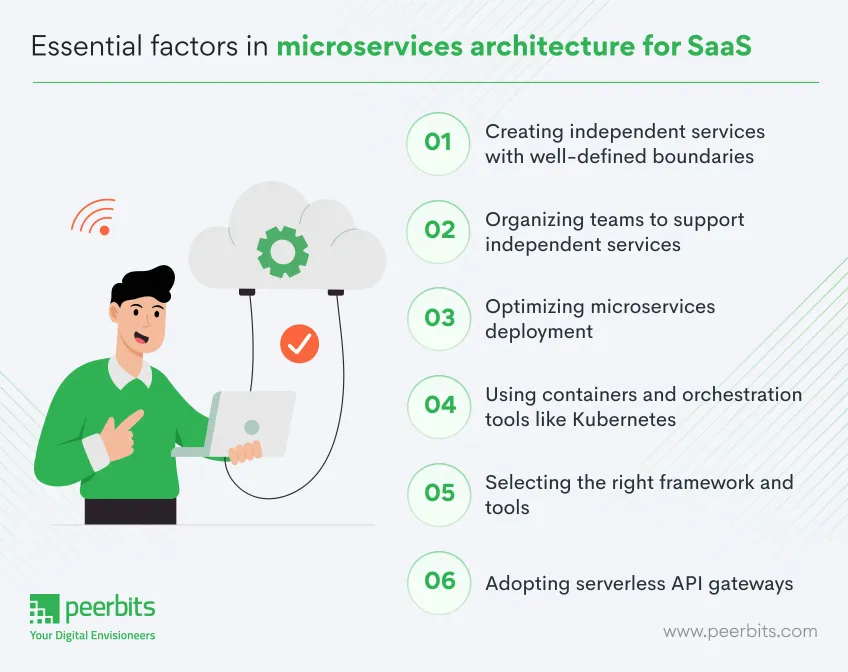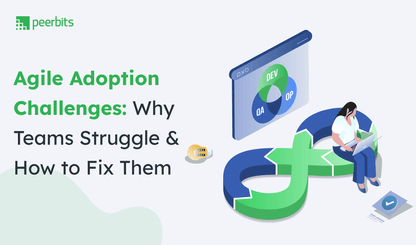Software as a Service (SaaS) has transformed how businesses operate. It offers cost-effective, scalable, and accessible solutions. Unlike traditional software, SaaS eliminates the need for on-site installations and ongoing maintenance, providing a more efficient and hassle-free solution.
A key factor behind the success of SaaS platforms is the adoption of microservices architecture. This design splits applications into smaller, independent services that function symmetrically, delivering improved performance and adaptability.
According to ScholarHat, 73% of big companies are using microservices architecture, showing its increasing popularity for building modular and scalable solutions.
This blog covers the key aspects of implementing microservices architecture for SaaS application development. It highlights the benefits, explores challenges, and provides actionable insights to help businesses build efficient and scalable SaaS platforms.
Microservices: Key traits and how they differ from monolithic systems
Microservices architecture helps build scalable and flexible applications by dividing them into smaller, independent services. Let’s see microservices and how they differ from traditional monolithic setups.
What are microservices?
Microservices are a modern architectural style in which an application is broken down into smaller, independent services. Each service operates autonomously and performs a specific task, communicating with other services through lightweight protocols like HTTP or messaging queues.
In traditional monolithic setups, the entire application is interdependent, meaning all components are tightly connected. Microservices are loosely coupled and helps each service to be development, deployment, and scale independency.
Key features of Microservices:
- Independence: Each service is autonomous, allowing developers to work on different services simultaneously.
- Modularity: Microservices are designed to perform a specific function, making the codebase more manageable and reusable.
- Decentralized data management: Each service manages its own database, reducing the risk of data inconsistencies across the application.
How microservices differ from traditional monolithic setups:
| Aspect | Microservices | Monolithic architecture |
|---|---|---|
| Structure | Divided into small, independent services | Single, unified application |
| Development | Can develop and deploy services independently | Requires the entire system to be developed and deployed together |
| Scalability | Individual services can be scaled independently | Entire application must be scaled together |
| Fault tolerance | Failure in one service doesn’t affect others | A failure in one part can bring down the entire system |
| Maintenance | Easier to update and maintain specific services | Updates require rebuilding the entire application |
| Technology stack | Different services can use different technologies | Entire system uses a single technology stack |
Characteristics of microservices:
Microservices bring several benefits, making them a strong choice for dynamic and complex applications:
Scalability for dynamic workloads: Microservices can scale individually, enabling applications to handle varying workloads without affecting other services. This improves performance during peak usage times.
Security for distributed systems: Each microservice has its own security protocols, reducing the risk of a single point of failure. Isolating services strengthens security, making it more difficult for attackers to breach the system.
Reliability through independent service management: If one service fails, it does not disrupt others, allowing the system to continue operating. This helps maintain service availability and resilience in SaaS applications.

Why microservices suit SaaS development?
Monolithic architecture, though effective in the past, presents several challenges in SaaS development. In monolithic setups, the entire application is built as a single unit.
This makes scaling and deploying features more difficult, especially as the application grows. A single change in one part of the system requires rebuilding and redeploying the entire application, which can lead to downtime and slower release cycles.
Microservices address these issues by breaking the application into smaller, independent services. This modularity helps with faster updates, better resource management, and less downtime.
Each service can be scaled independently and resulting better performance and efficiency. Microservices also reduce the risk of a complete system failure since each service operates autonomously.
Benefits for SaaS development
Quicker deployment cycles:
The development and deployment cycle becomes faster as teams can work on different services simultaneously with the help of microservices. This accelerates feature releases and updates, reducing time-to-market for SaaS product development.
Independent scaling for specific modules:
In microservices architecture for SaaS projects, each service can be scaled based on its specific needs. This means that resource-intensive modules can be scaled without affecting other parts of the application, it helps getting optimal performance.
Improved fault tolerance and performance stability:
Since microservices are independent, a failure in one service does not impact others. This isolation improves fault tolerance and ensures that the SaaS application architecture remains stable even when parts of the system face issues.
How microservices improve SaaS application architecture
Microservices bring flexibility, speed, and reliability to SaaS application development. By breaking applications into smaller, independent services, teams can create scalable, efficient, and resilient solutions to evolving business needs.
Building flexible SaaS solutions with modular design
Microservices help build SaaS applications using a modular design where each service operates independently. Services can be developed, deployed, and maintained separately, making it easier to scale specific components based on demand instead of scaling the entire system.
This design lets development teams focus on individual parts, creating a flexible and adaptable application that evolves with business requirements.
Read more: Explore the latest trends in SaaS Application Architecture Design
Speeding up SaaS releases with isolated deployments
A significant benefit of microservices is the ability to deploy and update services individually. In a monolithic structure, updating one part requires rebuilding the entire system, leading to delays.
Microservices simplify this by facilitating faster, isolated updates, so new features and improvements reach users quickly.
Optimizing resources with independent service management
With microservices, each service can be managed independently, making resource allocation more efficient. Services with higher demand receive the necessary resources, while others remain unaffected.
This reduces resource waste and improves the performance of the entire application.
Improving uptime and reliability for end-users
Microservices enhance reliability by isolating services, so a failure in one does not disrupt the entire application. This improves uptime and minimizes disruptions, providing users with a stable experience even during partial service failures.
Fault tolerance and resilience make SaaS applications more dependable for end-users.
Factors to consider when adopting microservices for SaaS applications

Implementing microservices in SaaS development requires complete planning and strategic decisions. Here are key factors to consider when implementing microservices for building scalable and efficient SaaS applications.
1. Creating independent services with well-defined boundaries
- Define clear boundaries between services, with each service handling a specific functionality.
- Ensure teams can work autonomously without interference.
- Avoid overlapping or tightly coupled dependencies to maintain flexibility and scalability.
- Services can be developed, updated, and scaled independently, a core advantage of microservices in SaaS.
2. Organizing teams to support independent services
- Structure teams based on the specific microservices they work on.
- Each team should be responsible for a specific service, focusing on its needs.
- Encourage cross-functional teams (developers, testers, etc.) to foster collaboration and avoid silos.
- This structure speeds up development and reduces bottlenecks in SaaS applications.
3. Optimizing microservices deployment
- Optimize service communication to reduce latency and redundant operations.
- Ensure each service performs efficiently by minimizing overhead.
- Faster and more reliable interactions lead to a smoother SaaS product development process.
4. Using containers and orchestration tools like Kubernetes
- Containers package services and dependencies, simplifying deployment and testing across environments.
- Kubernetes automates deployment, scaling, and management of containers, ensuring efficient resource usage.
- This improves the operation of microservices in large-scale SaaS environments.
5. Selecting the right framework and tools
- Choose frameworks and tools that align with the project’s needs (performance, security, ease of integration).
- Implement automation in the development pipeline to improve productivity and reduce manual tasks.
- Use CI/CD tools for seamless updates and features without service disruption.
6. Adopting serverless API gateways
- Use serverless API gateways to manage request routing, load balancing, and authentication.
- Simplify communication between services without complex infrastructure management.
- Solutions like AWS API Gateway or Kong provide efficient API management for SaaS development.
Conclusion
Microservices play an important role in transforming SaaS development by supporting scalable, flexible, and independent service management. With microservices, SaaS applications can be developed and deployed faster, efficiently meeting evolving customer needs and business demands.
Breaking down applications into smaller, manageable services helps businesses scale specific modules and address performance challenges more effectively.
When implementing microservices for SaaS, careful planning and informed decisions are crucial. Defining service boundaries, structuring teams, optimizing deployment, and selecting the right tools contribute to a successful implementation.
Partnering with a reliable software development services provider helps businesses create a microservices architecture. This structure improves performance, increases uptime, and makes SaaS applications more resilient to failure. It also supports faster updates and optimizes resources for future growth.

FAQ's
Microservices shorten deployment cycles by enabling updates or changes to individual services without affecting the entire system. This accelerates the development and release of features.
While not mandatory, containerization tools like Docker and Kubernetes simplify deployment, scaling, and resource management, making them highly recommended for microservices.
Serverless API gateways manage communication between services efficiently, routing requests without manual configuration. They also improve performance by optimizing API management.
Microservices are ideal for applications requiring frequent updates, scalability, or independent functionality. Simpler applications may still work well with a monolithic structure.
Tools like Prometheus, Grafana, and Elastic Stack are popular for tracking performance, detecting issues, and maintaining the health of microservices-based systems
Microservices are a strong option for startups aiming to scale over time. While the initial setup can be more complex, the flexibility and growth potential they offer make them a valuable choice for growing businesses.








